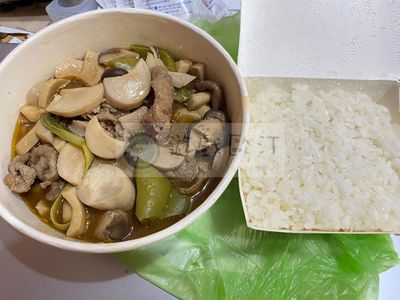中華料理名菜:黃悶牛的製作
黃悶牛是一道廣東省和廣西壯族自治區非常具有代表性的傳統菜餚,尤以客家人和壯族人最為常見。名字源自其烹飪方式和主要食材:黃牛肉,以及「悶」這種燉煮技法。以其肉質鮮嫩、味道濃郁著稱,深受南方人的喜愛,並經常出現在重要節日和家庭聚餐中。
黃牛,指的是在中國南方較為常見的一種本地牛種,其肉質結實且富有嚼勁,適合用來燉煮等長時間的烹調方式。相較於一般的牛肉,黃牛肉脂肪含量較低,但其肉味非常濃厚,經過適當的烹飪後,口感香嫩且有彈性,這使得它成為製作黃悶牛的理想食材。
製作方式講究「悶」這種烹飪技法,這是在鍋內長時間燉煮的過程,旨在讓肉質變得軟嫩入味。製作黃悶牛的關鍵在於燉煮的火候和時間掌控。首先,需要選擇黃牛的肩肉、牛腱等結實的部位,這些部位的肌肉纖維較粗,經過長時間的悶煮,會變得更加軟嫩。牛肉通常會先切成大塊,然後在沸水中汆燙,去除表面的血水和雜質。
接下來是調味和燉煮的過程,這是決定黃悶牛風味的核心步驟。一般來說,會使用生抽、老抽、八角、桂皮、香葉等常見的中式調味料來增添肉質的香氣。部分地區也會加入薑、蒜、豆豉等材料,這些香料能夠為牛肉增添層次感。黃悶牛的風味取決於這些調料的比例,以及燉煮的火候。烹調時,牛肉和調味料會放在砂鍋或大鐵鍋內,小火慢燉,這種悶燉過程通常會持續數小時,確保肉質軟爛,並充分吸收湯汁的香味。
主要的特色之一在於燉煮後的湯汁黏稠且色澤深邃,這是由於長時間的烹煮使得牛肉中的膠質釋放到湯中。完成後的菜肴應該呈現出牛肉軟爛,入口即化,同時保有肉的彈性和原始的鮮味。由於黃悶牛的燉煮時間較長,這道菜一般適合在家庭大餐或聚會時製作,可以提前準備,並在慢燉過程中讓味道逐漸濃縮,成為一道風味十足的菜餚。
除了傳統的燉煮方法,現代人為了節省時間,經常會使用壓力鍋來加快燉煮過程。壓力鍋可以在短時間內達到傳統燉煮所需的效果,使得牛肉快速變軟,保留其鮮美風味。無論使用何種方法,要在燉煮過程中讓牛肉吸收足夠的香料和調味,使每一口都能品嚐到豐富的層次。
黃悶牛的風味豐富而濃郁,適合搭配白飯或米粉食用,湯汁可用來拌飯或淋在米粉上,極為美味。在廣東、廣西地區,這道菜常常會成為婚宴、慶典等重要場合的主菜之一,代表著對賓客的尊重和款待。
Huang Men Niu (黃悶牛) is a highly representative traditional dish from Guangdong Province and the Guangxi Zhuang Autonomous Region, commonly seen among the Hakka people and the Zhuang ethnic group. The name derives from its primary ingredient, yellow cattle beef, and the cooking method known as "men," which refers to braising or slow-cooking. Known for its tender texture and rich flavors, Huang Men Niu is deeply loved by people in southern China and is frequently served during important festivals and family gatherings.
"Yellow cattle" refers to a local breed of cattle commonly found in southern China. Its meat is firm and chewy, making it ideal for long cooking methods such as braising. Compared to regular beef, yellow cattle beef is lower in fat, but it has a rich flavor that, when properly cooked, becomes tender and elastic. This makes it the ideal ingredient for preparing Huang Men Niu.
The cooking method is focused on the technique of "men," which involves slow-cooking the meat for an extended period to make it tender and flavorful. The key to making Huang Men Niu lies in controlling the heat and cooking time during braising. First, it is important to choose cuts of meat such as the shoulder or shank, which are muscular parts of the cattle with coarser fibers. These cuts become more tender through slow cooking. The beef is typically cut into large chunks and briefly blanched in boiling water to remove impurities and excess blood.
The next step is seasoning and braising, which is the core of the dish’s flavor. Common Chinese seasonings such as light soy sauce, dark soy sauce, star anise, cinnamon, and bay leaves are used to infuse the beef with fragrance. In some regions, ginger, garlic, and fermented black beans (doubanjiang) are also added, giving the beef a layered taste. The flavor of Huang Men Niu depends on the precise balance of these spices and the control of the heat during cooking. The beef and seasonings are placed in a clay pot or large iron pot and braised over low heat for several hours. This slow-cooking process ensures that the meat becomes tender and absorbs the flavor of the broth.
One of the main features of the dish is the thick, deep-colored broth produced by the long cooking process, as the gelatin from the beef is released into the soup. The final dish should showcase beef that is tender enough to melt in the mouth while retaining some elasticity and the beef’s natural savoriness. Due to the long cooking time, Huang Men Niu is typically made for large family meals or gatherings. It can be prepared in advance, and the slow-cooking process allows the flavors to gradually concentrate, resulting in a dish with robust flavor.
In modern times, people often use pressure cookers to expedite the cooking process. A pressure cooker can achieve the tenderizing effects of traditional braising in a much shorter time, making the beef soft while retaining its rich flavor. Regardless of the method used, it is crucial to ensure that the beef absorbs enough seasoning during cooking so that each bite is full of complex flavors.
Huang Men Niu is rich and flavorful, making it a perfect companion to rice or rice noodles. The thick broth can be poured over rice or noodles, creating a delicious combination. In Guangdong and Guangxi, this dish is often served as the main course at weddings, banquets, and other important occasions, symbolizing respect and hospitality towards the guests.

- 1
- 2
- 3
- 4
